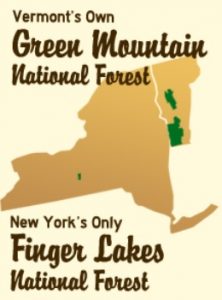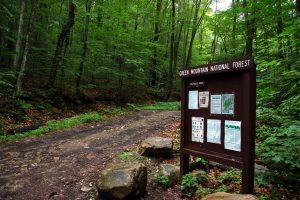When someone mentions boondocking, you typically think of public land in the western states. Mention boondocking and snowbirds in the same sentence and most people will narrow it down to the desert southwest and places like Quartzsite, Arizona where RVers migrate by the thousands every winter.
 But did you know that boondocking (dispersed camping) is also available on public land in the Northeast? It’s true. While I haven’t had the privilege to RV in the eastern portion of the United States, I am building a database on places where RVers are allowed to boondock (camping for free on public land) so when the day comes for me to head east in my RV, I will be ready.
But did you know that boondocking (dispersed camping) is also available on public land in the Northeast? It’s true. While I haven’t had the privilege to RV in the eastern portion of the United States, I am building a database on places where RVers are allowed to boondock (camping for free on public land) so when the day comes for me to head east in my RV, I will be ready.
One such place is the Green Mountain National Forest. The forest consists of 416,000 acres spread throughout southern Vermont.
The rules are very similar to what is allowed out west:
“Visitors can camp anywhere on the forest unless the area is posted closed to camping. Camp in existing sites or stay the strongly recommended 200 feet from roads, streams, trails, and bodies of water to disperse impact. Do not cut any vegetation. There is a camping limit of 14 days in any 30-day period on the Forest. Please leave the campsites clean by using Leave No Trace Principles, such as carry out what you carry in.”
While the forest is densely wooded, making it difficult to find campsites from space using Google Earth, the forest service has created a very detailed two-page document listing where the campsites can be found along with a dispersed camping page on their website.

Green Mountain National Forest. Photo by Rich Moffitt
Green Mountain National Forest by Rich Moffitt is licensed under CC BY 2.0
This is one of many listings:
“West Hill (White River Road) & Patterson Brook Roads: Secluded camping, open fields, and beautiful views are offered by the abundance of primitive campsites found along Forest Roads 50, 55, and 101 off of State Route 100 in Granville.”
What research I have done indicates the forest contains predominately deciduous trees and a fair amount of waterfalls. I suspect it is an even more beautiful place to camp during autumn when fall colors arrive.
Looking forward to boondocking in the Northeast, just another adventure in RVing!

The biggest shortfall on this article, is NO information on condition of navigation of roads. I would suggest to the author, to cover that in the article, otherwise one might get stuck on the “drive in” making for a very bad day of an attempted boondock. If you didn’t do your research for the article, mention that salient point.
Thanks, nice article!
Quoting above: “Camp in existing sites or stay the strongly recommended 200 feet from roads, streams,…”
Does this mean within 200 feet from roads,etc. or does it mean at least 200 feet away from roads, etc?
This information was taken directly from the website, I suspect the 200ft away from roads is aimed at tent campers..
The issue is “open dispersed” camping in the Green Mtn’s is way different than the wide open west. I would highly recommend scouting out any sites before driving your RV in. The forests of the Northeast are very dense, very rocky, with rutted dirt roads.
We are heading out later this summer for a 6 week VT, NH & MA trip. Combination of private, US Forest Service, State Park and national park campgrounds.
I echo the earlier comment about scouting these sites prior to trying to get an RV in them! There are places in both the Green Mountain and White Mountain National Forests that I would be hesitant to take my Subaru, much less a motorhome! More suited to truck campers…